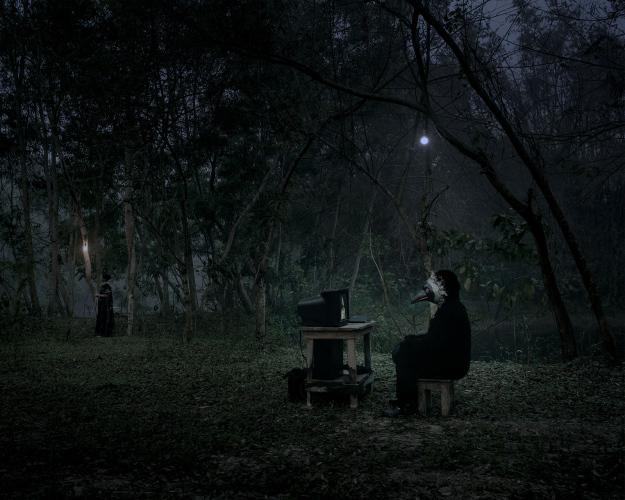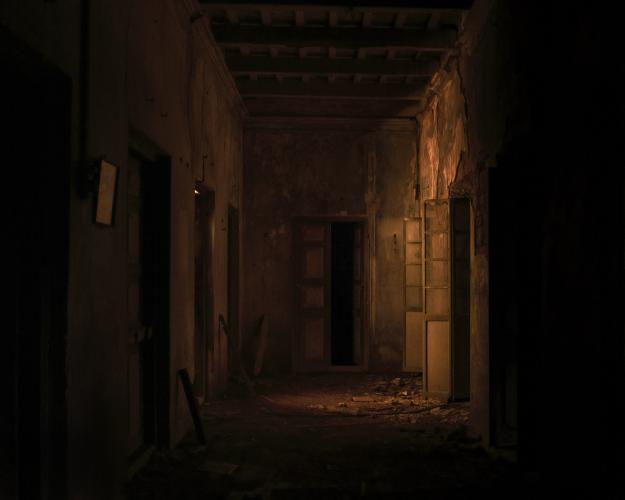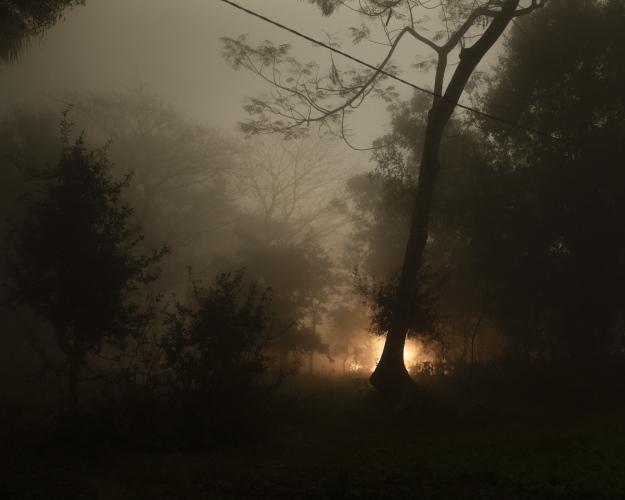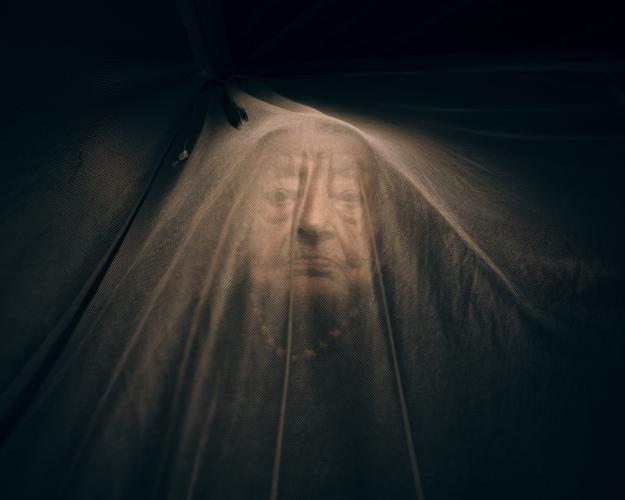This Cup of Spilt Memory: Soumya Sankar Bose’s A Discreet Exit through Darkness
A Discreet Exit through Darkness (2020–Ongoing) is a body of work by photographer Soumya Sankar Bose, which encompasses a series of photographs and his debut experiment with moving image in the shape of a 360° VR feature-length film. At the core of the work is the artist’s mother, who disappeared as a nine-year-old and was missing between 1969 and 1971. The incident remains unaccounted for within his familial histories, driven by the fallibility of memory and the scars left behind by trauma. Working with the mediums of moving image and virtual reality, Bose crafts an immersive environment for his viewers, inviting them to “enter” the fugue-like narrative of his past to find and piece together parts of a dream that cannot be grasped in its entirety.

The work expands upon the interplay of fiction and storytelling, a recurring theme in Bose’s practice. This hybridity is constituted by a texture that he continues to build critically, proceeding further into the realm of collective memory and the evasiveness of historical contexts. What becomes fascinating as the project unfolds—across photographs and moving images—is Bose’s position as a gentle instigator of “alternate archives,” a phenomenon he is keen to perpetuate and grow alongside his photographic endeavours into the history of his own family and of the region.
After a recent exhibition at the Experimenter Gallery in Mumbai and Kolkata, A Discreet Exit through Darkness is now being showcased at Les Rencontres d'Arles 2023. Shortlisted for the Discovery Award supported by the Louis Roederer Foundation, the project is part of a show curated by Tanvi Mishra at the Église des Frères Prêcheurs, one of the festival’s signature sites.
Annalisa Mansukhani (AM): Was there a specific starting point for this project, or was this a work that you were building towards over a period of time?
Soumya Sankar Bose (SSB): All of my work is interconnected, and some parts of A Discreet Exit through Darkness date back to approximately six years ago. However, 2020 held particular significance in the development of this body of work because I was determined to complete it within the next four to five years. My grandmother, who is in her nineties, is the only person in my family who remembers the details surrounding my mother’s disappearance in 1969. Remarkably, for almost fifty-one-years, nobody in my family had spoken about it. Yet, during the 2020 lockdown, I had the opportunity to spend more time with my family, which led to the sudden revival of a discussion about this incident. Intrigued by what I heard, I felt compelled to learn more.
I decided to visit the neighbourhood where my mother had lived, which is within walking distance from our current residence in Midnapore. Although the house no longer exists and has been replaced by a badminton court, I engaged in conversations with the locals. They shared with me the belief that the place was haunted, as they had “seen” an old man frequently visit, and consequently no one had built a house there in the past forty to fifty years. They believed that the ghost, whom I eventually understood to be my grandfather, was the one seeking his daughter, my mother. This revelation became a significant trigger for me during the Covid-19 pandemic.
During this time, I conducted interviews with family members and neighbours who recalled fragments of the incident. Meanwhile, my grandmother was hospitalised, adding a sense of urgency to my endeavours. I realised that if I did not complete this story and show it to my family, I would deeply regret it. As an artist, I believe in bringing the finished body of work back home to the protagonist, and this act holds immense importance to me. Unfortunately, I experienced the loss of several family members due to Covid-19, further emphasising the personal nature of this project. Failing to document this story would mean missing out on a precious opportunity to share an alternative archive of our family history with them.

AM: The relationship between photography, memory, truth and loss is something that remains a central line of enquiry for you across several of your projects. How does this work pick up on that strand? Is this an interrelationship you keep coming back to as a photographer?
SSB: My artistic practice serves as a journey that delves into a history intricately connected to my own roots. Every time I embark on a new project, I find myself asking a crucial question: What am I doing at this moment, and what is the significance of the work I am about to create?
When I worked on the Marichjhapi project, Where the Birds Never Sing (2017–2020), it was deeply linked to my father's side of the family. Similarly, the Jatra project, Let’s Sing an Old Song (2011–2015), had ties to my grand-uncle on my paternal side. The project exploring queerness, Full Moon on a Dark Night (2015), was profoundly personal right from its conceptualisation, as it stemmed from a deeply internal part of myself. Through my artistic practice, I am constructing my own personal diary as I seek to understand where I come from and who my people are. Having grown up in Midnapore, the stories I carry with me as I travel to Kolkata are all rooted in small-town narratives that are often overlooked. However, when placed within the larger context of India's history, they hold significant importance. This work itself is intertwined with a history of trafficking that permeates the region, referencing the Bangladesh Liberation War in 1971 and the Bengal Famine in 1943. Midnapore was greatly affected by the famine, resulting in mass migration to the Sunderbans.

Each project I undertake becomes a milestone, a crucial point in my ongoing journey, as I dive deeper into uncovering new stories and forging connections, seeking to comprehend and experience this history. In families, there is often a facade of happiness presented to the outside world, while deep down, the reality may be far from it. Moving from one work to another, I find myself immersed in the complex layers of family life, exploring how we hide so much beneath the surface. It is this concealment that fascinates me, and I relish the opportunity to delve deeper into its intricacies.
This project is deeply rooted in my personal history in a way that sets it apart starkly from my other work. There is no differentiation or separation I can make here; it is intertwined with my very being. Methodologically, it aligns with my previous works, such as Full Moon on a Dark Night and Where the Birds Never Sing, but it represents a more mature retelling of history, weaving together various threads and narratives.
AM: With your project on Marichjhapi, you dealt with the absence of a historical archive and moved towards the creation of one. What was the kind of narrative journey that arose with A Discreet Exit through Darkness regarding the history of the region? Could you share more about the historical contexts you were dealing with?
SSB: During my Marichjhapi project, I was travelling from place to place, collecting memories from various individuals. A Discreet Exit through Darkness held great interest for me because my grandfather played a central role in this chapter of the project. Currently, I am also in the process of developing the second chapter. In this first chapter, one of the components is a single-channel 360° VR, non-animated feature-length film that presents my grandfather's perspective after my mother's disappearance and depicts his deteriorating condition during that time. However, my mother herself is not visually portrayed in this film. To provide a crucial context for understanding the images in the films, I created a fictional diary—used as a voiceover at Arles this year—and it became an integral part of the work. The diary not only elucidates the circumstances during which my grandfather was searching for answers, specifically from 1969 to 1971, but it also sheds light on the complex socio-political events of the time, such as the Naxalbari movement and the unfolding Bangladesh Liberation War. These events caused significant delays and complications, involving the police and local political leaders, as well as many missing individuals, including women and girls who later shared their stories of either being trafficked or knowing someone who was.
At Arles, we are showcasing a range of stories beyond my mother's narrative. As I delved into the First Information Report (FIR) copies from the police archives, I discovered instances of women who had gone missing during that time but were subsequently rescued by the police. I found a way to incorporate these FIR reports as a means of connecting and communicating the intertwined stories, similar to my mother's experience. The collective stories span multiple generations and originate from this region and other Parganas; some of the people’s whereabouts remain unknown as they simply vanished. There is a profound interconnectedness within this context.

While developing the diary, I faced the challenge of limited sources. I was dependent on my grandmother, whose advanced age hindered her ability to recall the exact details of what had transpired. To supplement her memories, I sought assistance from newspaper archives to draw upon news articles, images and stories from Midnapore to enrich my work. For instance, I explored how the Noakhali riots impacted Midnapore, weaving it as a parallel story to my mother's disappearance. The second chapter of the project will delve into my mother's perspective, portraying her experience of being alone in the world, separated from her family. It will delve into what she endured during her absence away from home, and as she cannot recall that time, it will entail fictional elements. Currently, I am actively working on developing this aspect of the project.
To read more about Soumya Sankar Bose’s practice, revisit a walkthrough of Where the Birds Never Sing by the artist of the exhibition at Experimenter Gallery, Kolkata and Annalisa Mansukhani’s review of Where the Birds Never Sing.
All works by Soumya Sankar Bose from A Discreet Exit through Darkness (2020–Ongoing). Inkjet print on archival paper, mounted on dibond. Single channel 360/VR Film, 51 min 17 sec. Images courtesy of the artist.




